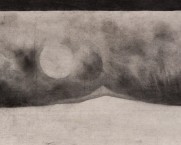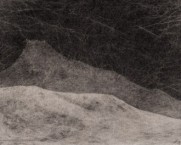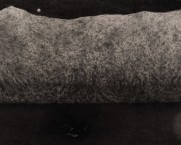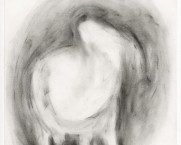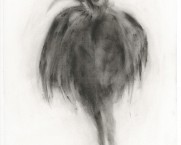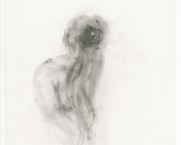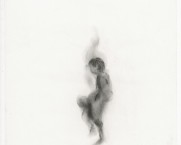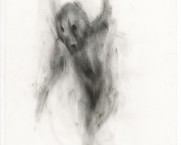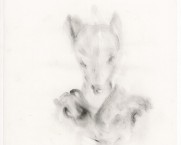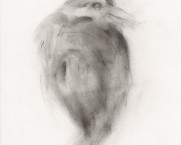C&L Shows
Drawing Phantoms: recent works
Minam Apang
2017
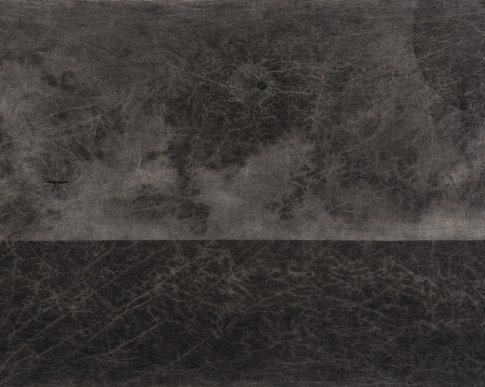
Overview
Nothing Stands Still
~ Zeenat Nagree
A splash. The black surface breaks. Its flatness pushed inwards by an unknown object creates waves. We do not know if we are at the beginning or in between a cycle. The order of the story, if there is one, slips out of our hands. All we have is a temporary threshold in the form of the disturbed water, grey against black, a trace of an arrival and a disappearance.
A threshold is a peculiar thing. A manifestation of the potential of movement, it marks the location of a passage between here and there, this and that. A threshold is also a point that must be crossed, an intensity surpassed so that something may happen between then and now. When the unknown body dives into the black water, something happens, a point of entry is created. What will re-emerge? While looking at the threshold created by this disappeared body, we are already compelled to survey the landscape that lies on either side—a looming wall of mountains against a dark sky, a small moon and its improbably large reflection in a dark expanse of water. There are other views of this world that appear to be in states of passage themselves. The water, the mountains and the moons, all traversed by currents of energy plucking up each of their surfaces, all folds looking for contact. This is a world familiar yet alien, caught in a moment of churning. The currents hold that very moment in place while pushing it into another state.
—
Using charcoal on cloth and on paper, Minam Apang creates imaginary landscapes and hybrid creatures for her present series titled, Drawing Phantoms. Certain elements continue to reappear. Of them, the most enduring is the mountain range, depicted as vast and extraordinary but also gently dissolving in the mist. The moon, too, is seen in imposing and minuscule forms throughout the works, and often more than one is drawn in the sky, locating us not here but elsewhere. Alongside this preoccupation, which emerges from growing up in the mountainous terrain of Mussoorie and Arunachal Pradesh, other works demonstrate the artist’s intense familiarity with the sea and its shifting waves, an outcome of moving to the coast of Goa.
These biographical facts can only inadequately explain why certain landscapes and forms continue to entice Apang. It might be more pertinent to think of the act of drawing itself as a form of discovery, as John Berger has written. Looked at this way, drawing can be considered a journey for the artist, involving a close examination of the visible that is given over to the imagination. The chosen materials—here, charcoal on cloth and paper—determine Apang’s process of discovery through their own specific possibilities. As the artist draws, the creases in the cloth and the smudges of the hand on the paper play a part in orienting the creation of a work. Even before the first mark is made, the process of improvisation in the studio begins. As Maurice Merleau-Ponty has observed, there is no hierarchical relationship between the mind and the body but an enmeshed working.
Over the last six years, Apang has done away with the image’s dependence on text that characterised her early work on episodes from various folk tales. Yet, the hybrid creatures that Apang continues to draw, like the bird with legs seen in this exhibition, are untethered from playing particular roles in a story. Who – or what – these figures are, then, becomes a process of discovery for the artist and the viewer.
—
A bat, dark with taut wings. It flies in an overcast sky during an eclipse. The arrival of the winged creature in the midst of a celestial crescendo must be some kind of intervention, a turn of events, an inevitable occurrence, or an insignificant detail. Has the bat crossed a threshold from one world to another? Where is it headed?
This single inhabitant, the bat, presents the possibility of creating a narrative. It has the devices necessary to carry the story forward with its unexpected entrance and the potential ability to cause a disruption. Yet, another element at the centre of the landscape draws attention. It is the eclipse which in its misalignment takes the form of an eyeball, surrounded by currents that extend out to the entire world like nerves into a body. The eye confronts the eye/I of the viewer, interrupting the seduction of story-making. From here on, the horizon is a line, a straight one, or even slanted, a drawn line before it can be seen as the imaginary line where land or water meet and separate from the sky. This line divides the images into two parts, one veering towards dark greys and black and the other towards light greys and white. This solid division moves up and down, and even if it dissolves into turbulent waves, fierce clouds, and mist, it provides a compass to contemplate the beginning of the creation of every image.
A trio of phantoms. They dance on the black land. Wispy at the edges, these figures move—to a beginning or an end, or somewhere in between, we cannot tell. The currents have been set in motion or finally tamed. Do these three bodies haunt the landscape or do they enact the haunting of invisible spirits that animate their world at a minute scale? From images and experiences we have inherited, we can identify the possibility of the unfolding of a ritual, in which the body slips from one state to another, while remaining indeterminate.
To see a phantom is to accept its potential to activate the imagination. A phantom is an illusion only possible through suggestion. It exists, even if it does not, and in doing so it throws reality into question. The legibility of a phantom is open to individual interpretation. Even as the shape that a phantom seems to take emerges from a single or singular encounter, the understanding of its potency is derived from an accretion of experiences and obsessions. It is within these individual variations of looking at a phantom that shared patterns emerge, and an indication of the anxieties and euphorias of the present seem to come to the forefront. In a way, the present could always be imagined as a moment that is turning away from the past and turning into the future, always a state of passage. The tenor of this fleeting moment of the present, its charge and chaos, and the hope or the disillusionment it holds are like phantoms—visible to those who see them. Although dark and often in upheaval, the images do not offer anything fixed or certain. Are we, in this present, at the beginning, somewhere in between, or hurtling towards an end?
Mumbai
September, 2017
Biography:
Minam Apang was born in Naharlagun, Arunachal Pradesh, and received her BFA from Elmherst College, Illinois, and an MFA from Sir J.J. School of Art, Mumbai. She has had multiple solo exhibitions at Chatterjee & Lal, Mumbai. She has also showcased her work in institutional group exhibitions at venues including Hara Museum, Tokyo; Gallery of Modern Art, Brisbane; and the New Museum, New York.
She lives and works in Goa.

